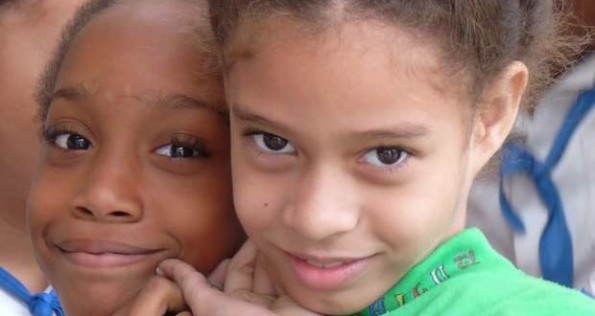Iván García, 29 April 2015 — The first time that Yumilka, a teacher, felt discriminated against because of the color of her skin she was only four years old. “It was in the daycare center. I remember coming home crying. A group of children called me ‘negritilla’ or lousy black girl. They didn’t want to share their toys with me. My parents talked to the director and she told them that this was just kid stuff, which couldn’t be classified as racism.”
Racial prejudice continued into her youth. When her boyfriend, a caucasian, took her home to his parents, their silent treatment had an overtly discriminatory overtone.
“After we broke up, I learned that his parents criticized him for not finding a ’whiter’ woman, since they were not in favor of ’combing raisins.’ His father told him that black women were for having sex with, but not for marrying. These were members of the Communist Party, who worked in foreign trade,” recalls Yumilka.
Laritza Diversent, a dissident lawyer, also suffered racist humiliations when she did her baccalaureate studies at the Lenin Vocational School, an elite center founded by Fidel Castro on the outskirts of Havana.
“Besides being black, I was very poor. Everyone looked at me like a freak when I arrived. The children of senior government officials studied at Lenin. Almost all were white and many were not only racist, but outspoken,” recalls Laritza.
In a primary school in the Havana township of Diez de Octubre in Mariana, a sixth-grade student says that humiliations based on skin color happen almost every day.
“Most black students are the poorest—those without tablets, who wear patched sneakers, and bring bread with salad oil for their snack. Not just the white kids call them names, but the mixed-race ones also,” he says.
Racism in Cuba is a phenomenon that the regime tries to hush up, or does not give the full attention it deserves. After 25 years of perpetual economic crisis, social differences have accentuated racial segregation.
During that time, worse than racial discrimination is the pervasive social control by the state, the low participation of citizens in shaping policy strategies, and the outright apartheid of the military autocracy, which excludes Cubans under the new Investment Law or prohibits them access to boats in tourist centers.
Fidel Castro did not bring racism to Cuba. More or less subtly, there were always prejudices based on skin color, facial features, or “kinky” hair. There were parks and clubs for whites only. Even the dictator Fulgencio Batista, a mestizo, was denied entry to one of those clubs.
Although slavery was abolished in Cuba in 1886, blacks were left at a clear disadvantage in the social order. They had neither property nor wealth. Their educational level was low.
In 1912, the Independent Party of Color, led by Evaristo Estenoz and Pedro Ivonet, took up arms and about 3000 blacks and mestizos were massacred by the government of José Miguel Gómez.
At the head of the officers who executed the shooting was Colonel José Martí, son of the illustrious Cuban hero and humanist. 103 years later, the national historiography wants to soft pedal the criminal event.
There is no evidence that Fidel Castro is racist. But he had a clumsy political strategy for handling the issue. Upon establishing a system where supposedly no social classes existed, he assumed that racial discrimination had disappeared with the triumph of his revolution.
Racism did not disappear, it merely mutated. It disguised itself in various forms, and white supremacy in key state positions became permanent. Fifty-six years after his rise to power, blacks are only a majority in the crowded Cuban jails.
Finding statistics on inequality is cumbersome. The state archives contain few figures. But according to Fidel Castro himself, in a speech in January 2000, 80% of the prison population was black or mixed race.
As a rule, blacks on the island live in the worst housing, earn the lowest wages, do not finish college, and in order to move up the social ladder turn to sports, Santeria, music, or military life.
Currently, a large number of policemen are black or mixed race. So are many of the henchmen who repress dissidents. That does not stop them from having a racist modus operandi.
When conducting raids, they often detain black or mixed race youths. “It’s the operating profile. A black with a backpack is always a suspicious guy,” said a policeman.
According to the dissident Juan Antonio Madrazo, national coordinator of a citizens committee for racial integration, “in Cuba there is an ideology of whitening.”
Among blacks and mestizos, pressure has been applied to marry or have children with white people “to advance or improve the race.”
According to a sociologist consulted, the number of marriages or consensual unions between blacks and whites has skyrocketed in the last 15 years. “Racism in Cuba is most evident in the sectors of culture, the media, and companies with foreign capital and foreign trade.”
Nuria, a housewife, believes that racial taunts and humiliation during childhood are of concern. “It’s a problem of family education. It is in the home where these children hear slurs against blacks.”
The regime has created the Aponte Commission to draw up a more accurate map of racism. Intellectuals like Roberto Zurbano, Sandra Alvarez, and Victor Fowles recognize that the phenomenon is a veritable Pandora’s box.
One hundred and twenty-nine years after slavery was abolished in Cuba, blacks remain prisoners of their race. Yumilka, the teacher who suffered humiliation at just four years of age, asks, “How much longer?”

